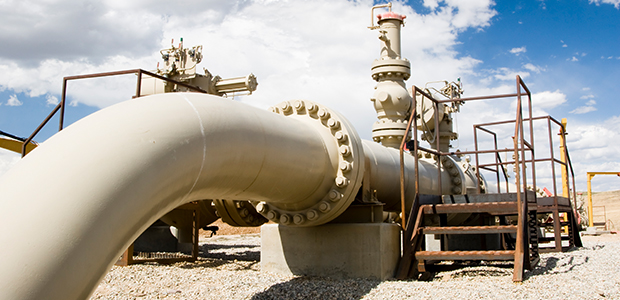
Growing Export Demand To Accelerate Midstream Consolidation
GREENWOOD VILLAGE, CO.—In its annual outlook, East Daley Analytics predicts that natural gas production will fall early in 2024 but climb 0.5 Bcf/d before the year’s end.
The ramp up will begin in June 2024 and start in earnest in July and August in response to storage inventories that will fall short of their five-year averages, East Daley forecasts. The firm attributes the inventory deficit to declining production and below-average injection rates.
According to East Daley, April Henry Hub spot prices will fall to $2.63. But by the end of 2024, the storage deficit should push them to $4.00.
Upward price pressure will continue in 2025 thanks in part to higher demand from liquefied natural gas export terminals, East Daley assesses, noting that the Plaquemines liquefaction facility is expected to come on line in the first quarter. East Daley estimates that LNG export demand will average 14.6 Bcf/d in 2025, a 2.8 Bcf/d (24%) increase over 2023. The increase will help the Henry Hub spot price average $3.88, 26% higher than in 2024.
In 2026, East Daley says it foresees downward pressures on prices returning as production growth shrinks the storage inventory deficit. “Production will average 109.8 Bcf/d in 2026 to support ramping LNG export demand as 3.9 Bcf/d of incremental liquefaction could be in service by the end of the year,” the report describes. “Henry Hub spot prices will average $3.64, $0.24 lower than 2025, but still higher than 2023-24 average prices.”
By 2027, inventory levels will exceed the five-year average, East Daley projects. However, LNG startups in the second half of the year could exceed 5.4 Bcf/d and “erode the storage surplus once more, even in the face of production levels that sustain above 111 Bcf/d for the year.” While the Henry Hub spot price will average $3.57 for the entire year, the firm says the fourth quarter’s average will reach $4.30.
“From 2027 to 2030, volatility is subject to the completion of liquefaction that may achieve (a final investment decision) in the coming months and the pipeline infrastructure associated with those facilities,” East Daley suggests. The firm’s bull case calls for 34.6 Bcf/d of LNG export capacity by year-end 2030, while its bear case calls for 27 Bcf/d.
“In sum, U.S. (natural gas) demand increases by 22 Bcf/d by 2030 over 2023 levels, led by growth in LNG exports,” East Daley predicts.
Upstream and Midstream Implications
As LNG demand comes on line, drilling in the ArkLaTex/Haynesville region and Eagle Ford Shale should intensify. From 2023 to 2030, the ArkLaTex region will boost production 12.9 Bcf and the Eagle Ford will increase it 3.0 Bcf/d, East Daley forecasts. The firm adds that the Anadarko Basin, western Rocky Mountains and Barnett also will accelerate drilling activity to fill a 2.0 Bcf/d gap between supply and demand that will emerge by 2030.
“Export demand, especially for LNG, provides one of the largest growth opportunities for midstream,” East Daley suggests. “We expect LNG exports to almost double and exports to Mexico to increase by 1.2 Bcf/d through 2027. We also expect natural gas liquids and crude exports to increase by 400,000 barrels a day and 1.1 million barrels a day, respectively.”
Given the regulatory complications associated with investments in greenfield projects, East Daley suggests that many midstream companies will support export growth through mergers and acquisitions. Indeed, “midstreamers have already started to use M&A to boost their exposure to this tailwind, such as Williams with its acquisition of Trace and Energy Transfer with its acquisition of Enable Midstream.”
According to East Daley, some midstream companies will secure lower acquisition costs by buying assets in second-tier basins that likely will increase production as export demand rises. As cases in point, East Daley cites Williams’ acquisition of Cureton in the Denver-Julesburg Basin and Kinder Morgan’s purchase of STX Midstream in South Texas.
NGLs
In addition to making acquisitions, midstream companies are using their free cash flow to build pipelines that will transport NGL out of the Permian Basin for the next 5-10 years. East Daley calculates that 60% of midstream CAPEX budgets in the Lower 48 are focused on the Permian, with 49% of that geared toward NGLs.
“(NGL) capacity looks ample, driving heavy competition for molecules and leading to downward pressure on transportation and fractionation rates,” East Daley suggests.
East Daley’s 2024 outlook report includes more details on the natural gas, NGL and midstream consolidation trends discussed above, as well as forecasts related to crude oil. To download the report, watch a webinar about it or see short videos summarizing each section, visit 2024 Domestic Oil & Gas Industry Outlook.
For other great articles about exploration, drilling, completions and production, subscribe to The American Oil & Gas Reporter and bookmark www.aogr.com.






